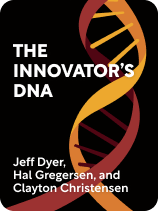

This article is an excerpt from the Shortform book guide to "The Innovator’s DNA" by Jeff Dyer, Hal Gregersen, and Clayton Christensen. Shortform has the world's best summaries and analyses of books you should be reading.
Like this article? Sign up for a free trial here.
Does your product or business need a breakthrough? How can you find new doors to open?
Disruptive innovators ask disruptive questions. In The Innovator’s DNA, Hal Gregersen, Jeff Dyer, and Clayton Christensen argue that anyone can learn to innovate by practicing the five skills of the most successful innovators in the world. One of those skills is asking questions that disrupt the status quo.
Read more to learn how to use catalytic questions to unleash your inner innovator.
Catalytic Questions
The authors write that innovation is the key to success in today’s business environment, and the key to innovation, in turn, is creative thinking. The authors focus on what they call disruptive innovation, which creates entirely new markets by radically diverging from established products, services, and processes (as opposed to innovation that only improves upon current ones). Disruptive innovation drives significant growth and creates value by transforming entire industries and bringing breakthrough solutions to customers.
The authors describe five behaviors and skills—what they call Discovery Skills—that are most likely to generate creative ideas. These are associative thinking, questioning, observing, idea networking, and experimenting. Asking catalytic questions improves your associative thinking by helping you gather crucial information about the status quo and then imagining new connections, possibilities, and directions for radical change.
(Shortform note: According to neuroscientists, asking questions improves your ability to think associatively by engaging your brain’s reward system and prefrontal cortex. When you ask questions, your brain releases dopamine, a neurotransmitter associated with pleasure and motivation. This can increase your curiosity and your drive to seek out more information. The prefrontal cortex, the region involved in planning, reasoning, and decision-making, is also activated by asking questions. This region helps you focus on relevant information, organize your thoughts, and see patterns you may not have noticed before.)
The authors’ research found that innovators not only asked more questions, they asked more disruptive questions—catalytic questions that challenged assumptions and looked at established products, services, and processes from new angles. For example, Trusted Housesitters, an online platform that matches traveling people with free places to stay in exchange for pet care, began with the question, “Why should traveling people pay for places to stay and pet owners pay for pet sitters when they could trade?”
Particularly when you encounter a problem that requires a creative solution, like how to fill a gap in the market, it’s often more fruitful to spend time asking questions about the problem first rather than trying to come up with solutions right away. If you brainstorm solutions too early in the process, you may get stuck solving the wrong problems. When you ask the right questions, you’ll understand the dimensions of the problem much better, and then you’re set up to find the right creative solutions.
(Shortform note: Outside of the book, Gregersen uses the term catalytic questions to describe the kind of disruptive questions that challenge the status quo and open up new avenues for exploration. According to Gregersen, when you jump straight into trying to find solutions, you are limited by your existing assumptions and biases, which prevents you from seeing the problem in a new light. By contrast, asking catalytic questions helps you challenge your assumptions and explore the problem from different angles, which can lead to more innovative and effective solutions.)
Techniques for Practicing Catalytic Questioning Skills
The authors offer two techniques for practicing your ability to question. The first is a set of four types of questions, and the second is an exercise called QuestionStorming.
The four types of questions that will help you challenge the status quo are: defining, origin, limit-testing, and imagination questions.
- Defining Questions: These help you define and describe the current status of products, services, and processes. By understanding what is, you can imagine what could be. For example, you could study customers as they interact with current products to understand their physical, cognitive, and emotional experiences with them (this is closely related to the Discovery Skill of observing).
- Origin Questions: These help you discover the real problem with a current product, service, or process and how it got to be what it is today. For example, you might ask: Why are things working the way they are? What got us to our current way of doing or thinking about something?
- Limit-Testing Questions: These help you explore possibilities for improvement or ways to disrupt the status quo. For example, you could ask: How could this product, service, or process improve? Could we do it entirely differently? Why or why not?
- Imagination Questions: These questions allow you to perform thought experiments by imagining things differently. For instance, you might ask: What would happen if we did it this way or that way instead?
(Shortform note: The questions outlined above correlate to three question categories proposed by Matthew Dixon and Brent Adamson in The Challenger Sale to encourage innovative thinking in sales managers. Their question categories are questions that increase your understanding (which relate to defining and origin questions), questions that widen your perspective (which align with limit-testing questions), and questions that expand your options (which correlate to imagination questions). They explain that asking questions in each category can help you fully explore opportunities for innovation and problem-solve effectively.)
The second technique is to brainstorm for questions (an activity the authors call QuestionStorming). This exercise will strengthen your questioning skills and provoke deeper inquiries about the root causes or core elements of a problem. QuestionStorming involves coming up with a least 50 questions about the identified problem and then attempting to answer them only after you’ve listed and prioritized them.

———End of Preview———
Like what you just read? Read the rest of the world's best book summary and analysis of Jeff Dyer, Hal Gregersen, and Clayton Christensen's "The Innovator’s DNA" at Shortform.
Here's what you'll find in our full The Innovator’s DNA summary:
- The five key skills that are shared by the world's innovation leaders
- Why innovation in business is so important
- How to sustain innovative organizations and teams long term






